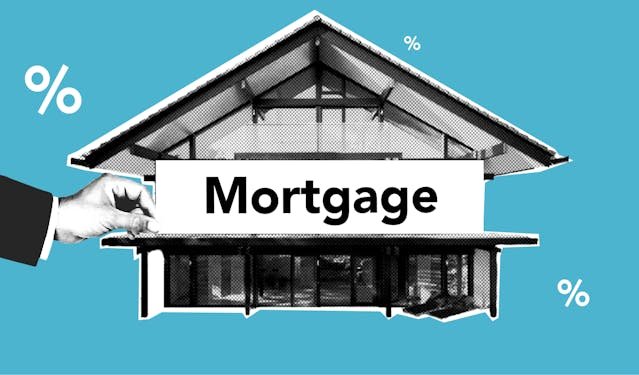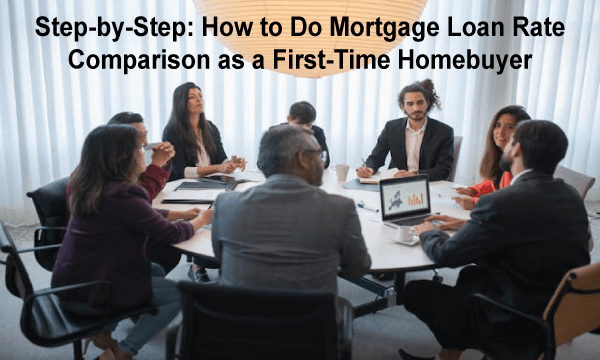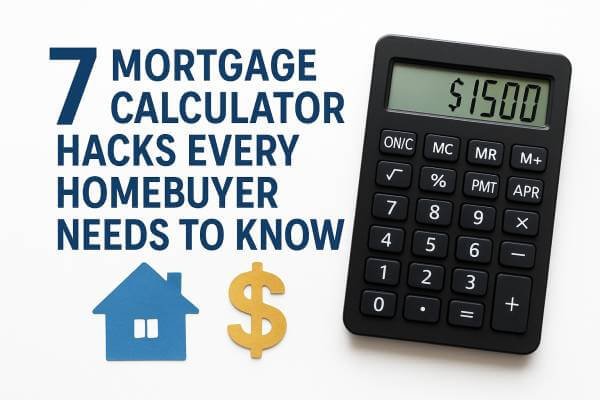Step-by-Step Guide to Get a Mortgage as First-Time Homebuyer in the US

Are you considering a mortgage as a first time homebuyer? That’s a journey that could be exciting and a little overwhelming at the same time.
Getting a mortgage as a first time homebuyer can feel like something that is difficult or impossible. What does it all even mean?
If you’re like most people, you might be wondering, Where should I begin? Who do I talk to? And how much money do I need? Trust me, you’re not alone. The process can seem intimidating, but it doesn’t have to be.
In this step-by-step guide, I’ll walk you through the whole mortgage journey—from checking your credit to finally getting those house keys in your hand.
Whether you’re new to the process or simply need a refresher, I’ve got you covered. Let’s break it all down.
Step-by-Step Guide To Get a Mortgage as First Time Homebuyer
Step 1: Assess Your Financial Readiness
Before you even start looking at houses, take a good look at your finances. Getting a mortgage as a first time homebuyer means lenders will be all up in your business, which includes your credit score, income, debt, savings, etc.
Start by checking your credit score. The higher it is, the better your chances of locking in a rate. Next, look at your debt-to-income ratio (DTI). If you’re spending most of your paycheck on bills, now’s the time to cut back.
Also, ask yourself, do I have enough saved up for a down payment and closing costs? If not, don’t panic—there are loan programs designed to help first-time buyers with low down payments.
Bottom line? The more prepared your finances are, the smoother the mortgage process will be. You want to show lenders you’re responsible, reliable, and ready.
Step 2: Understand Your Mortgage Options
Now that your finances are in check, it’s time to explore your mortgage options. And trust me, there’s more than one way to get a mortgage as a first time homebuyer.
You’ve probably heard of fixed-rate and adjustable-rate mortgages. A fixed rate keeps your payments the same every month. Treat for budgeting. Adjustable-rate mortgages (ARMs) usually start low but can increase over time, which can be risky if you’re not prepared.
Then there are loan types like FHA, VA, USDA, and conventional loans. If you’ve got a smaller down payment or a less-than-perfect credit score, an FHA loan might be your best bet.
VA loans are amazing if you’re a veteran, and USDA loans work well if you’re buying in a rural area. Conventional loans typically require higher credit, but they offer more flexibility in the long run.
Not sure which one’s right for you? That’s okay. The key is to understand what’s out there so you can choose the best fit for your situation.
Not all mortgages are created equal, and picking the wrong one could cost you thousands. Therefore, it is crucial to take your time, ask questions, and compare your options before making a final decision.
Step 3: Get Pre-Approved for a Mortgage
Pre-approval is the crucial stage. If you’re a first time homebuyer seeking a mortgage, this step signals your readiness to proceed.
So what is pre-approval, exactly? It’s when a lender takes a close look at your finances, i.e., your income, credit score, debts, and job history. The lender then informs you about the maximum amount they are willing to lend you. It’s akin to receiving permission to begin your home search within your financial constraints.
You’ll need to gather some documents: pay stubs, W-2s, tax returns, and bank statements. Essentially, these documents serve as evidence of your ability to afford the loan. Don’t worry; it’s paperwork you probably already have lying around.
Getting pre-approved not only boosts your confidence but also sets you apart from other buyers. In a competitive market, sellers are more likely to take your offer seriously if you’ve already got your financing lined up.
Step 4: Determine Your Home Buying Budget
Before you start scrolling through dream homes on Zillow, let’s talk about realistic numbers.
Getting a mortgage as a first time homebuyer isn’t just about what the bank says you can afford. It’s about what you can comfortably handle month after month.
Just because you’re approved for a $400,000 loan doesn’t mean you should spend it all. Look at your income, monthly expenses, and savings goals. Leave room for life emergencies, repairs, vacations, and takeout nights. You know, the stuff that makes life what it is.
Lenders look at something called your debt-to-income ratio (DTI). This measurement is how much of your income goes toward debt each month. A lower DTI means you’re less risky in their eyes (and might get a better rate).
Online mortgage calculators can help you run the numbers. But at the end of the day, it’s about what makes you feel secure, not stretched.
Buying your first home should feel exciting, not financially terrifying. Set a smart budget now, and you’ll thank yourself later.
Step 5: Shop for Lenders and Compare Rates
Here’s the part most first time buyers skip, and it can cost them big time. As a first time homebuyer, avoid choosing the first lender who confirms your approval. Seriously, shopping around can save you thousands over the life of your loan.
Different lenders offer different interest rates, fees, and loan terms. Even a small difference in your rate, say, 6.75% vs. 6.25%, could mean hundreds of dollars a month (and tens of thousands over the years).
Start by getting quotes from at least three different lenders. This list could include big banks, credit unions, online mortgage companies, or even a mortgage broker who shops the market for you.
Step 6: Choose the Right Mortgage Lender
Choosing the right lender for your mortgage as a firsttime homebuyer isn’t just about getting the lowest rate. It’s also about trust, communication, and support.
You need to ask yourself:
- Is this lender responsive when I have questions?
- Do they provide clear explanations without overwhelming me with jargon?
- Are their fees transparent, or are there unexpected additional charges?
If the answers aren’t clear or something feels off, walk away. You want a lender who treats you like a person, not just a number on an application.
Also, check online reviews or ask friends and family who’ve recently bought homes. Having a solid reputation is crucial, particularly when you’re navigating the homebuying process for the first time.
Remember, the lender you choose will be your partner during one of the biggest purchases of your life. Choose someone who earns your confidence, not just your business.
And don’t just focus on the rate. Look at the APR (annual percentage rate), which includes fees, and ask about things like closing costs, loan processing fees, and any penalties.
Step 7: Complete the Mortgage Application
It’s time to formalise your decision. Once you’ve picked your lender, the next step in getting a mortgage as a first time homebuyer is filling out the full application.
If you’ve already received pre-approval, you’ll have an advantage. The majority of the information remains consistent: income, employment, assets, debts, and personal information.
Here’s what you’ll likely need:
- Recent pay stubs
- W-2s or tax returns
- Bank statements
- ID and Social Security number
- Info about any other assets or debts
Pro tip: Be 100% honest and accurate. Even small mistakes or missing info can slow things down or, worse, trigger a denial. If there are any changes to your financial situation, such as switching jobs or acquiring new debt, please inform your lender as soon as possible.
Step 8: Underwriting and Appraisal Process
Once you submit your mortgage application, the underwriting and appraisal process begins. This is the initial phase of securing a mortgage for a first time homebuyer. But don’t worry; we’ll break it down.
Underwriting is when your lender’s team double-checks everything concerning your income, credit, debts, job status, and financial history. If anything seems off, they might ask for more documents. It’s totally normal, so don’t panic.
At the same time, your lender will order an appraisal of the home you’re buying. Why? They need to make sure the house is actually worth what you’ve agreed to pay. If the appraisal comes in lower than the offer price, you may need to renegotiate with the seller or bring more money to the table.
This stage can take a couple of weeks, so stay flexible and responsive. The faster you provide anything they ask for, the smoother things will go.
It might feel like a waiting game; this is where the real approval happens. You’re almost there; don’t give up now!
Step 9: Receive Your Loan Estimate and Closing Disclosure
With underwriting and appraisal nearly wrapped up, it’s time to talk numbers officially. When you’re getting a mortgage as a first time homebuyer, two documents will spell out exactly what you’re signing up for: the Loan Estimate and the Closing Disclosure.
Your loan estimate shows the interest rate, monthly payment, estimated taxes, insurance, and all the closing costs. This document is sent early in the process, usually within three business days of your application, so you can review it and ask questions.
Then, a few days before closing, you’ll receive the Closing Disclosure. It’s like the final invoice for your mortgage. Compare it to the loan estimate and make sure nothing has changed unexpectedly, especially fees.
If something doesn’t look right, speak up. Ask questions now, not after you’ve signed the contract.
Step 10: Close on Your Mortgage and Get the Keys
After all the paperwork, planning, and waiting, you are now prepared to finalise your mortgage as a first time homebuyer and move into a new home.
At closing, you’ll sit down (either in person or online) and sign a stack of documents. Yes, it’s a lot of signatures, but every one gets you closer to your front door. You’ll also pay your closing costs and bring any remaining down payment, usually via a certified check or wire transfer.
Once you sign everything and transfer the funds, you own the keys. Seriously. You’re now a homeowner.
It might feel a little surreal, but this is what all your preparation has led to. Take a deep breath, snap a photo, and celebrate. You’ve earned it.
The Mortgage Benefits of Being a First-Time Homebuyer
Being a first time buyer does not imply any disadvantages. In fact, if you know where to look, it can provide you with powerful tools and savings. It comes with more perks than you might expect. You’ve got advantages that repeat buyers often don’t. Some of which include the following:
Special Loan Programs Just for You
Obtaining a mortgage as a first-time home buyer frequently provides access to government-backed loan programs such as FHA, VA, or USDA loans. These programs are designed to lower the barrier to entry, with benefits like
- Low or no down payment requirements
- More lenient credit score standards
- Lower interest rates in some cases
Down Payment Assistance & Grants
Many states and cities offer down payment assistance programs, grants, or forgivable loans to help first time buyers with upfront costs. These programs can cover your down payment, closing costs, and even moving expenses, with some of them not requiring repayment.
Tax Breaks & Incentives
Depending on where you live, first-time buyers may qualify for state or federal tax credits, mortgage interest deductions, or property tax exemptions. These can lower your tax bill and help offset the cost of homeownership.
Educational Resources & Buyer Support
You’ll find tons of free homebuyer education courses geared toward first-time buyers. Not only can pre-approval boost your confidence, but completing the process may also qualify you for better mortgage terms or lender discounts.
Legal Protections and Buyer-Friendly Policies
Some states offer added protections for first-time buyers, such as mandatory seller disclosures or the right to back out of a contract under certain conditions. These give you a little more breathing room while navigating the process.
Top Mortgage Tips for First-Time Home Buyers
Obtaining a mortgage as a first-time home buyer can be challenging, but there are several clever shortcuts and undiscovered benefits that can streamline the process and reduce costs.
1. Look Into First-Time Home Buyer Programs
Many states and cities offer down payment assistance, reduced interest rates, or grants just for first-time buyers. Check with your local housing authority—you might be surprised what’s available.
2. Take a Homebuyer Education Course
Some lenders and government programs (like FHA or USDA loans) offer better terms if you complete a short online course. It’s a small time investment that can pay off in big savings.
3. Don’t Drain Your Savings
While it may be tempting to allocate all your resources towards the down payment, refrain from doing so. Keep some cash set aside for moving costs, furniture, and unexpected home repairs (because yes, something will eventually break).
4. Lock in Your Interest Rate at the Right Time
Rates can change daily. Ask your lender about rate locks and the best time to secure yours—it could save you thousands over the life of your loan.
5. Keep Your Credit (and Spending) Steady Before Closing
Avoid big purchases, switching jobs, or opening new credit cards before your loan closes. Lenders often do a final check, and last-minute changes can delay or even kill the deal.
6. Ask About Tax Credits and Deductions
Some first-time buyers may qualify for tax breaks that can significantly reduce their expenses. It’s always smart to talk to a tax pro to see what you might qualify for in your area.
7. Stay Patient and Ask Questions
Obtaining a mortgage as a first-time home buyer involves a learning curve, and that’s perfectly acceptable! No question is too small. Stay curious and keep asking until you fully understand what you’re signing.
Common Mortgage Mistakes First-Time Home Buyers Must Avoid
Even with the best intentions, it’s easy to trip up when getting a mortgage as a first-time home buyer. Here are some common mistakes to be aware of, along with tips on how to avoid them effectively:
❌ Not Getting Pre-Approved Early
Skipping pre-approval is like trying to book a vacation without checking your passport. You need to know what you can afford before falling in love with a home.
❌ Overestimating Your Budget
Just because a lender approves you for a certain amount doesn’t mean it’s wise to max it out. Stay within a budget that leaves room for real life—emergencies, hobbies, and yes, pizza nights.
❌ Opening New Credit Accounts Mid-Process
Should you use a credit card from a new furniture store? Yeah, don’t do it. Any significant financial change during the process could potentially trigger concerns from your lender, leading to a delay or rejection of your approval.
❌ Ignoring the Fine Print
Don’t just skim your loan estimate or closing disclosure. Read everything carefully. Hidden fees or unexpected terms can sneak in if you’re not paying attention.
❌ Focusing Only on the Interest Rate
A low rate is great, but it’s not the only thing that matters. Fees, lender service, and loan terms all play a big role. Always look at the full picture.
Avoid these slip-ups, and you’ll make the path to homeownership much smoother.
Quick Checklist: Resources for First-Time Homebuyers
Use these trusted resources to make smarter, more confident decisions on your journey to homeownership:
- Government Programs & Assistance
- HUD First-Time Buyer Resources:
https://www.hud.gov/buying
(Find local homebuyer programs, housing counselors, and FHA loan info.) - Down Payment Resource Tool:
https://downpaymentresource.com
(Search for grants, assistance programs, and special offers in your area.) - State Housing Finance Agencies (HFAs):
https://www.ncsha.org/housing-help/
(Use this map to find your state’s official housing agency and programs.)
- Loan & Rate Tools
- FHA Loan Info—U.S. Department of Housing and Urban Development:
https://www.hud.gov/program_offices/housing/fhahistory - VA Loan Program—U.S. Department of Veterans Affairs:
https://www.va.gov/housing-assistance/home-loans/ - USDA Loan Eligibility Map:
https://eligibility.sc.egov.usda.gov/eligibility/welcomeAction.do
(See if your area qualifies for a USDA no-down-payment mortgage.)
- Credit, Budget, and Education
- FICO® Score Estimator:
https://www.myfico.com/Fico-Credit-Score-Range-Estimator
(Get a quick estimate of your credit score range.) - CFPB Home Buying Tools:
https://www.consumerfinance.gov/owning-a-home/
(Interactive guides, loan comparison tools, and mortgage help.) - HUD-Approved Housing Counselling:
https://hudgov-answers.force.com/housingcounseling/s/
(Find a certified housing counselor near you.)
Tip: Bookmark this list or save it to your notes. These resources can help you save money, avoid scams, and make smarter decisions as you apply for a mortgage as a first-time home buyer.
Conclusion
Obtaining a mortgage as a first-time home buyer need not be a daunting task. Now you’ve got the steps, the tips, and the confidence to move forward.
Do you require assistance in initiating the process? Talk to a lender, gather your documents, or share this guide with a friend. You’re not just buying a home; you’re building a future. Let’s go get it.
❓ Frequently Asked Questions (FAQ)
1. What is the minimum credit score required to get a mortgage as a first-time home buyer?
Most lenders require a minimum credit score of 580 for FHA loans, but you may need 620 or higher for conventional loans. The better your score, the better your rate.
2. How much down payment do I need as a first-time home buyer?
Some loan programs allow as little as 3% down, and others (like VA or USDA loans) may require no down payment at all. FHA loans typically require 3.5%.
3. What’s the difference between pre-qualification and pre-approval?
Pre-qualification is a quick estimate based on basic info, while pre-approval involves a detailed review of your finances by a lender and carries more weight with sellers.
4. How long does the entire mortgage process take?
On average, the full mortgage process—from application to closing—takes about 30 to 45 days, though it can vary depending on your lender and the complexity of the loan.
5. Can I buy a house with no money down as a first-time buyer?
Yes, VA and USDA loans offer 0% down payment options, and some state or city programs also provide down payment assistance for eligible first-time buyers.
6. Do first-time home buyers pay lower mortgage rates?
Not necessarily, but they may qualify for loan programs with reduced rates or more flexible terms. Your credit score, loan type, and market conditions will still affect your rate.
7. What documents do I need to apply for a mortgage?
Typically, you’ll need pay stubs, W-2s or tax returns, bank statements, ID, and details about your debts and assets.
8. Are there any tax benefits for first-time home buyers?
Yes, you may be eligible for mortgage interest deductions or first-time homebuyer credits, depending on current federal or state programs. Consult a tax professional to be sure.
9. What is PMI, and will I have to pay it?
PMI (Private Mortgage Insurance) is usually required if your down payment is less than 20% on a conventional loan. This assistance increases your monthly payment until you accumulate enough equity.
10. How do I find first-time homebuyer assistance programs near me?
Start by checking with your state’s Housing Finance Agency or use tools like DownPaymentResource.com to search programs based on your location.
Footnotes & Sources
To ensure accuracy and transparency, the following authoritative sources were used to support data and insights in this guide on getting a mortgage as a first-time home buyer:
- National Association of Realtors (NAR)—Home Buyer and Seller Generational Trends Report
https://www.nar.realtor/research-and-statistics
(Provides insights on first-time buyer demographics, down payments, and generational trends.) - FICO® – Average U.S. Credit Score Data
https://www.fico.com/blogs
(Used to reference national credit score averages and how they impact loan approval.) - Consumer Financial Protection Bureau (CFPB)—Understanding Credit Scores
https://www.consumerfinance.gov/ask-cfpb/what-is-a-credit-score-en-315/
(Explains how credit scores influence mortgage eligibility and rates.) - Freddie Mac – Primary Mortgage Market Survey (PMMS)
https://www.freddiemac.com/pmms
(Official source for weekly average U.S. mortgage interest rates.) - Mortgage Bankers Association (MBA) – Mortgage Market Research & Forecasts
https://www.mba.org/news-research-and-resources/research-and-economics
(Used to support trends in mortgage applications and rate forecasts.) - U.S. Department of Housing and Urban Development (HUD) – FHA Loans and Home Buying Assistance
https://www.hud.gov/buying/loans
(Cited for FHA loan benefits and down payment assistance programs.) - U.S. Department of Veterans Affairs (VA) – VA Home Loan Benefits
https://www.va.gov/housing-assistance/home-loans/
(Provides official VA loan eligibility and benefit info for veterans.) - U.S. Department of Agriculture (USDA) – Guaranteed Rural Housing Loan Program
https://www.rd.usda.gov/programs-services/single-family-housing-guaranteed-loan-program
(Referenced for zero-down mortgage options in qualifying rural areas.)



















